Saint Helier — Jersey
I stayed in Roscoff for three days, once again with the wrong wind direction, namely northeast. I used this time to have a last look around Brittany. Even though this is certainly a beautiful place, I just have the feeling that I’ve seen it all before.
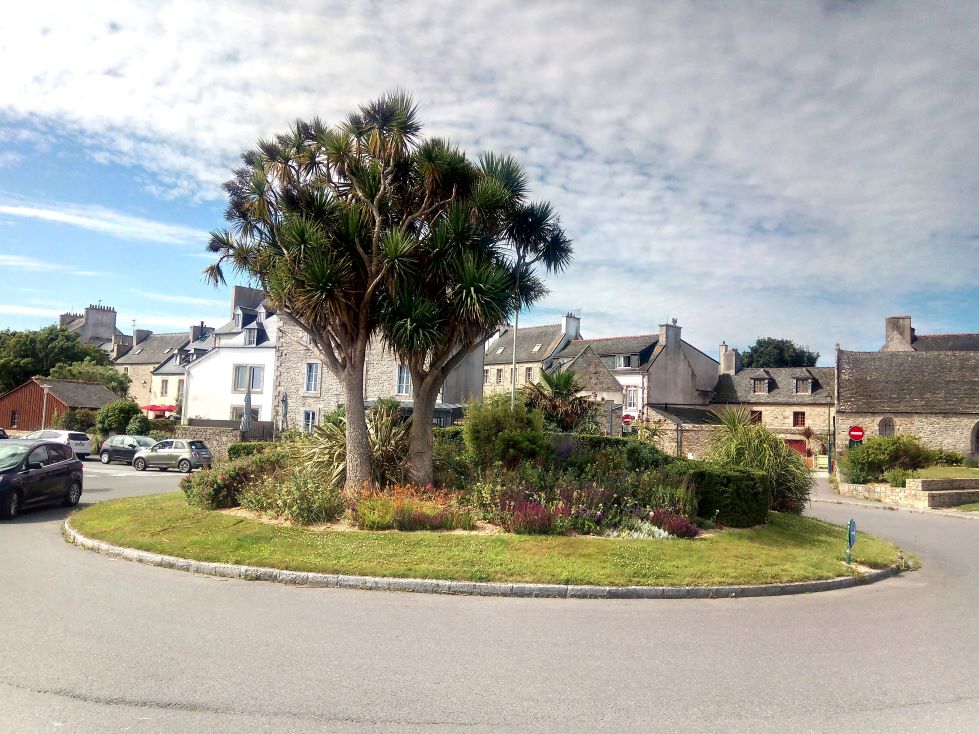
Breton-style houses with green traffic islands
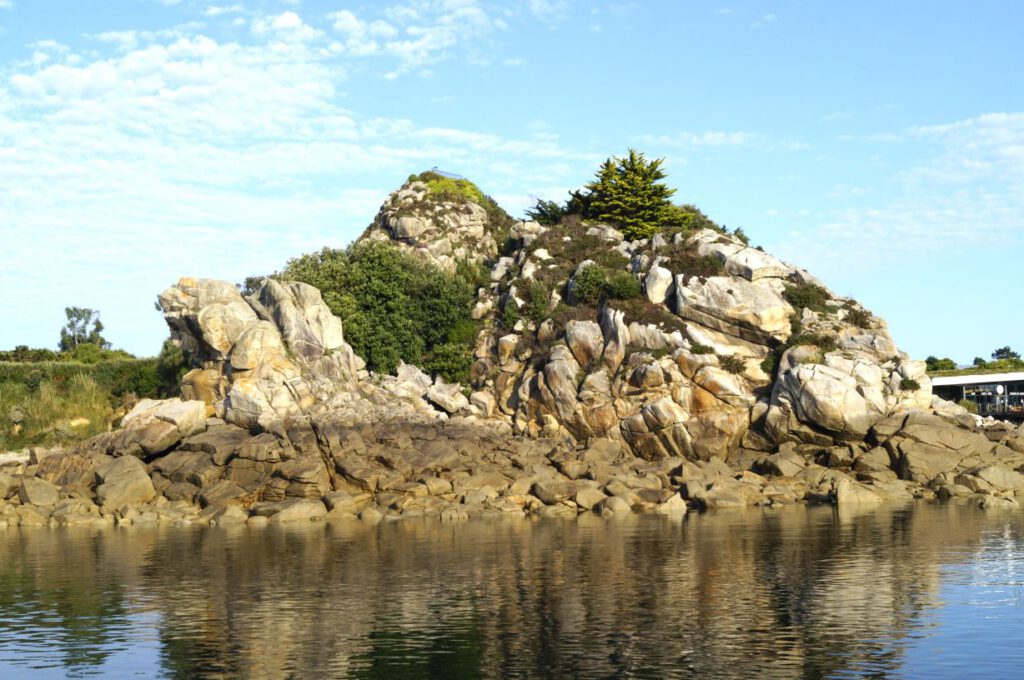
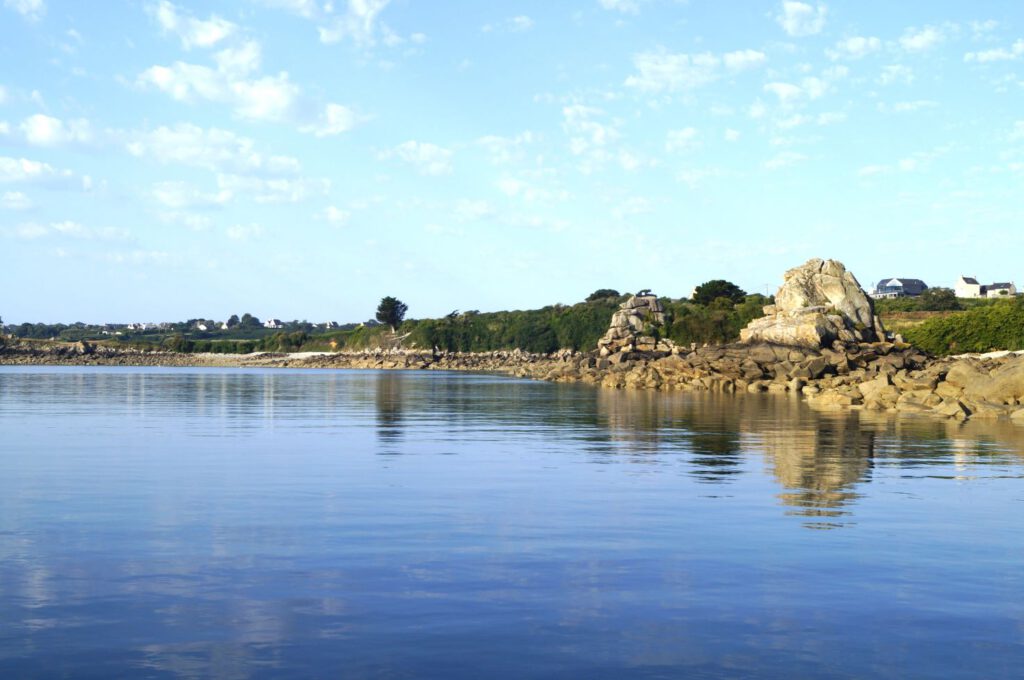
Rocks in Roscoe-harbour
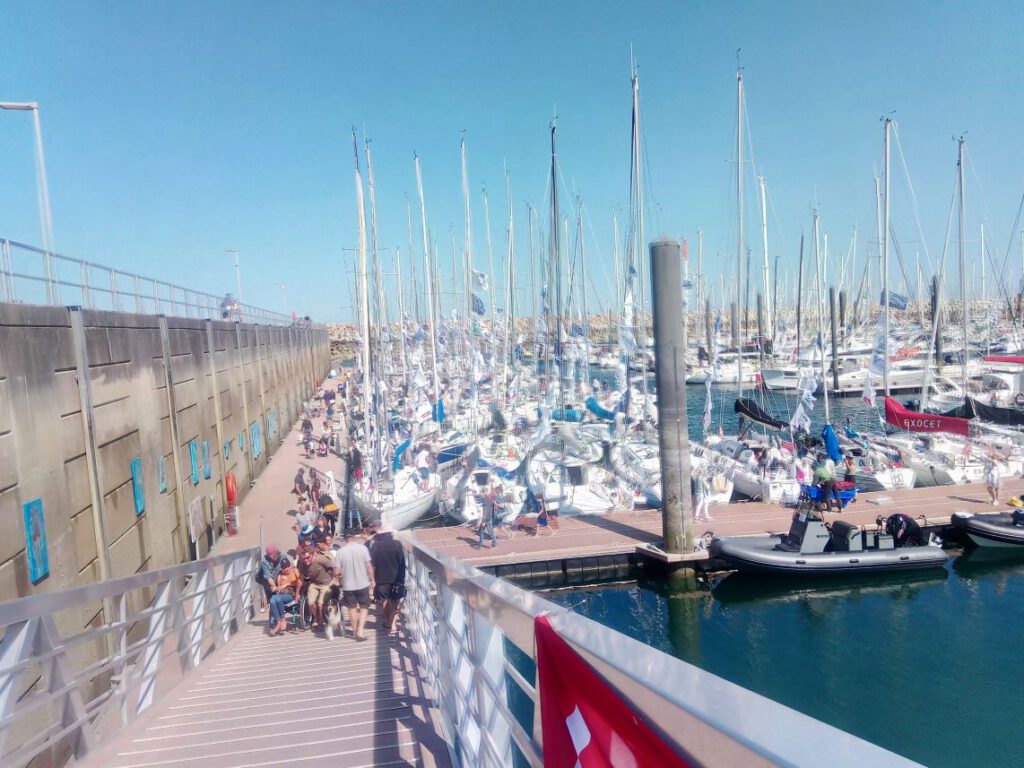
This was a bit new. They’re sailing a regatta around the Finistére, pretty much following my route backwards in stages. They’re doing it against the current, otherwise may be, they’d probably be going too fast. I checked it out on marinetraffic: 7 knots over ground with 2 knots counter current, not bad.
Then I continued on to Trebeurden, with the forecast light wind I didn’t want to tear off 49 nautical miles to Lezardrieux, even if there was a good current. However, the wind wasn’t that weak.
The rocky coast in northern Brittany is special. That’s why I’ve taken a series of pictures because I haven’t documented it much so far.
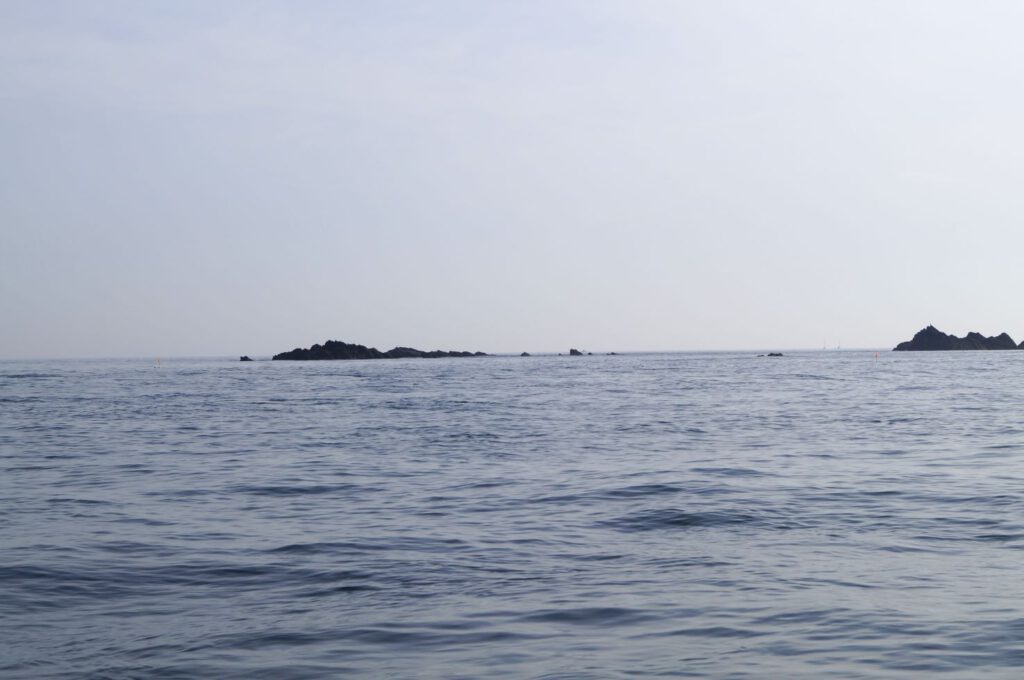
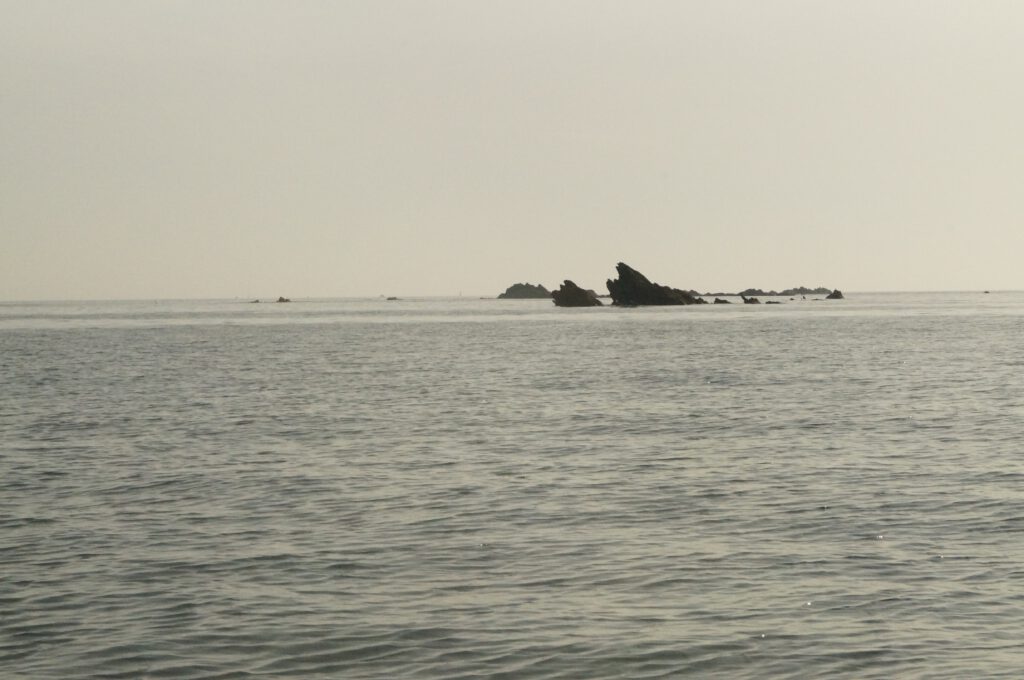
Beautiful sailing between the rocks.
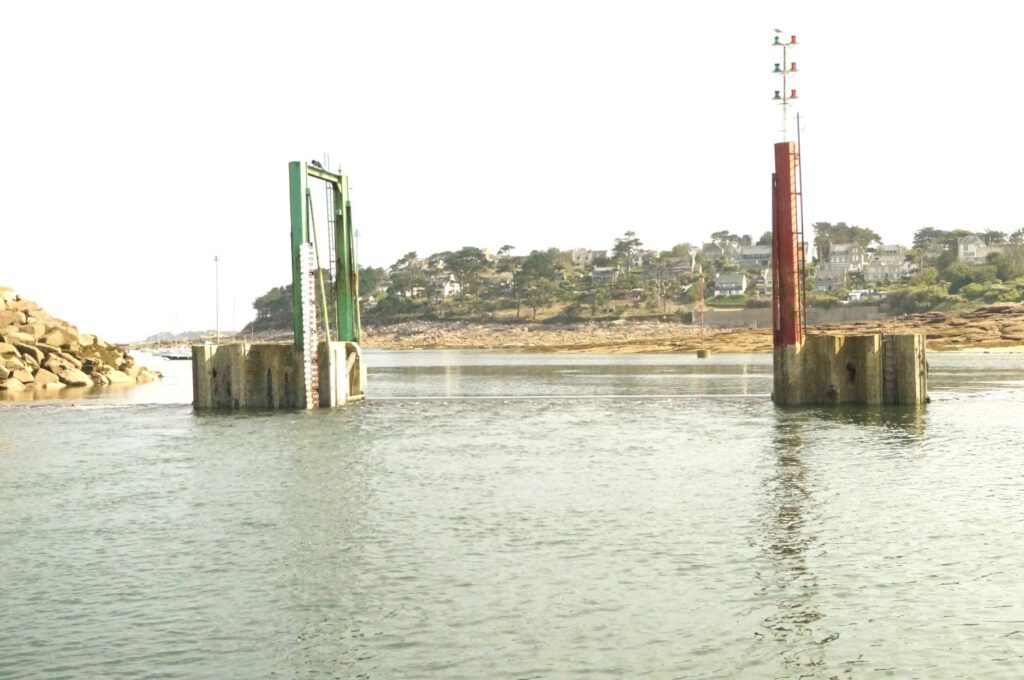
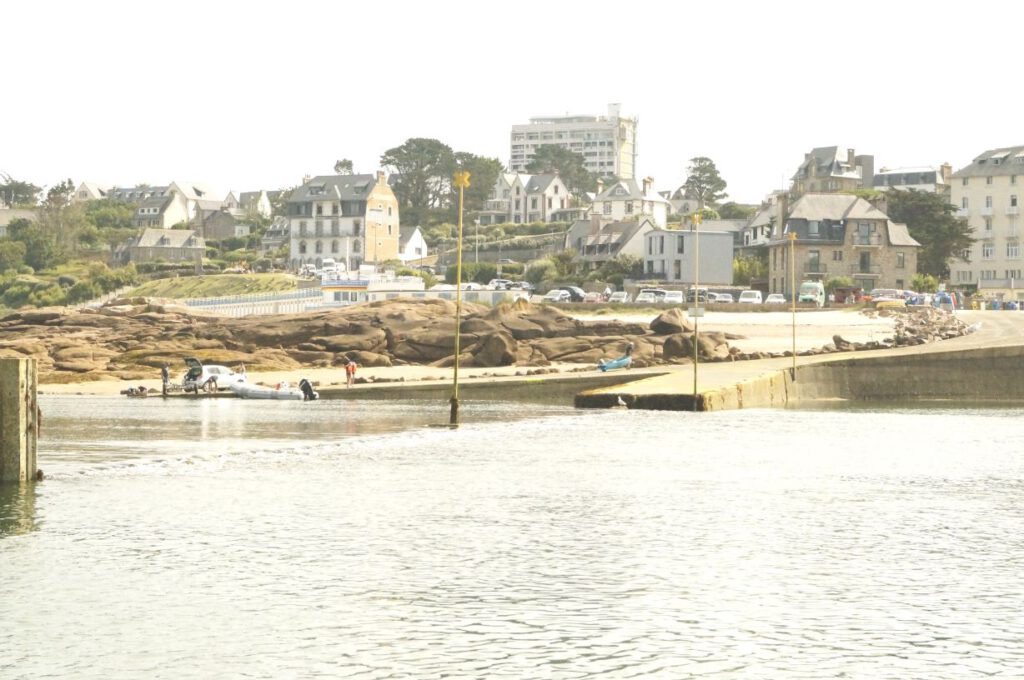
Trebeurden entrance gate and Sill
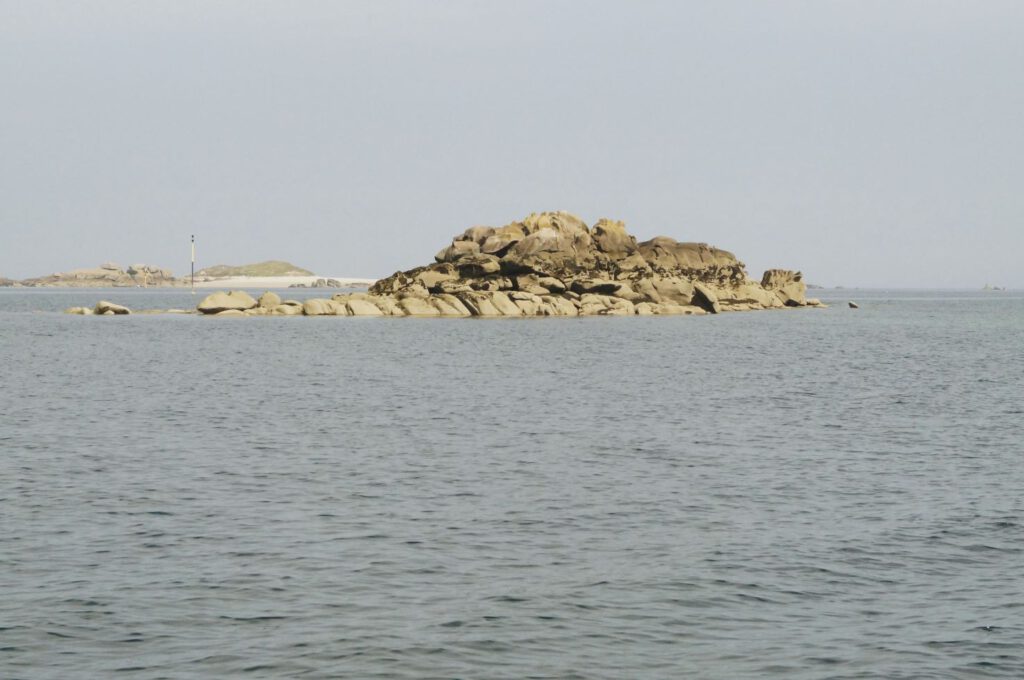
Rocks in front of the entrance to Trebeurden
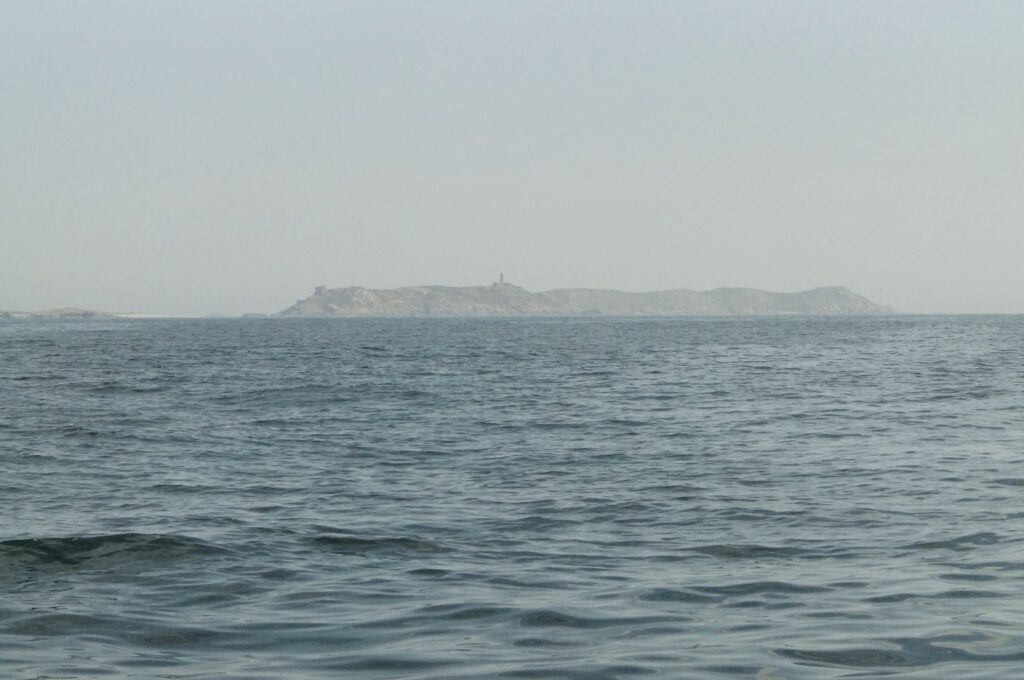
Actually the Ile de Sept are also just rocks.
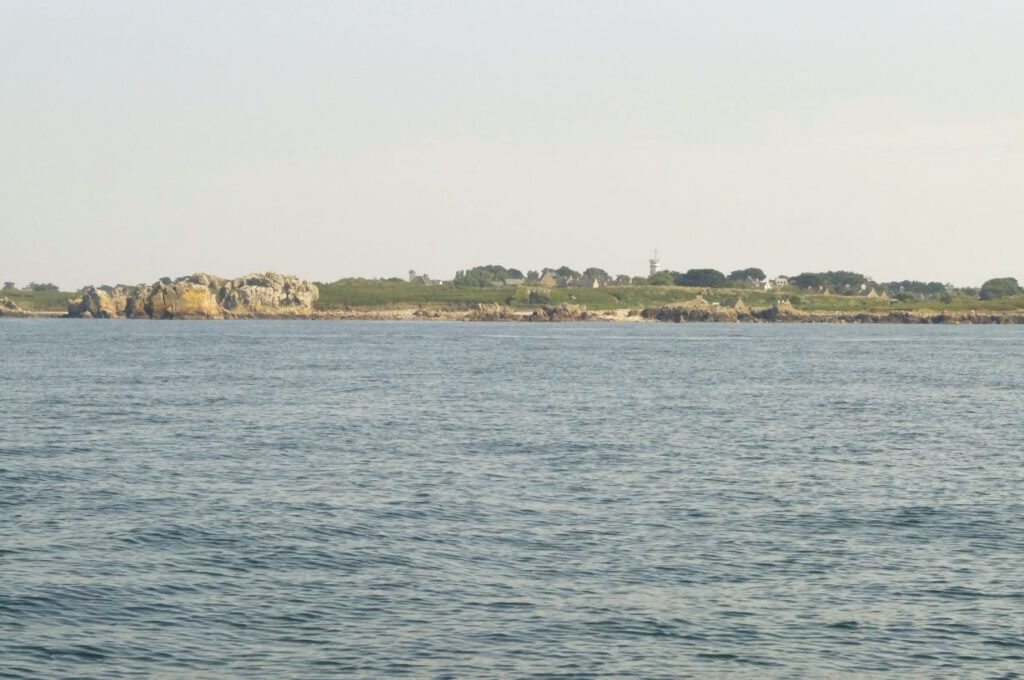
The largest of the seven islands inhabited and has a lighthouse.
The trip to Lezardrieux was quite choppy with zero wind. The outboard motor doesn’t like that at all, especially when it goes on for 9 hours. It cut out again when we moored in Lezardrieux. A familiar problem. Nevertheless, I had to keep going and hoped that it would sort itself out.
Finally, there was a good breeze from astern on the trip to Saint Helier. First I pulled in one reef, but that wasn’t enough for the 47 nautical miles.
Unfortunately, this rocking trip also had an effect on the engine. It doesn’t like this at all, according to my experience. I don’t know whether it’s dirt being stirred up from the tank or other problems. In any case, I can’t throttle back the engine when it’s running, then it cuts out. Of course, you can’t manoeuvre like that in the harbour. With a bit of skill, I was still able to dock in Lezardrieux and casting off is not difficulty. The engine has to go to a workshop.
In Saint-Helier on Jersey, what I feared happened again: the engine cut out while manoeuvring in the harbour. I was brought to the waiting pontoon by the harbour staff with a yellow warning light. They obviously enjoyed it and everyone jumped in to help with the mooring. Here at the waiting pontoon in front of the Sill, you can also moor by full service (water, electricity, and Wi-Fi). The next day I found a workshop and the engine being worked on. The mechanic immediately said there was dirt in the engine and tank. If the engine runs smoothly again, it’s a very reassuring feeling for the rest of my journey.
Now I’ve left Brittany, the next harbours are already in Normandy, Dielétte and Cherbourg.
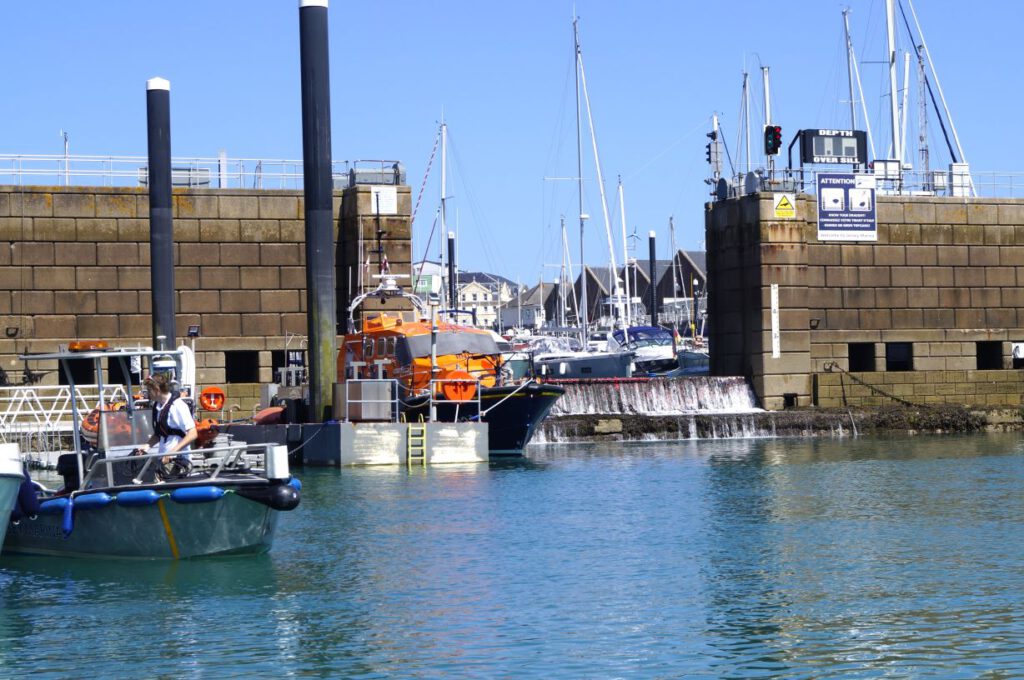
Jersey Marina entrance: Sill at low tide (the small “lifeboat” on the far left of the picture)
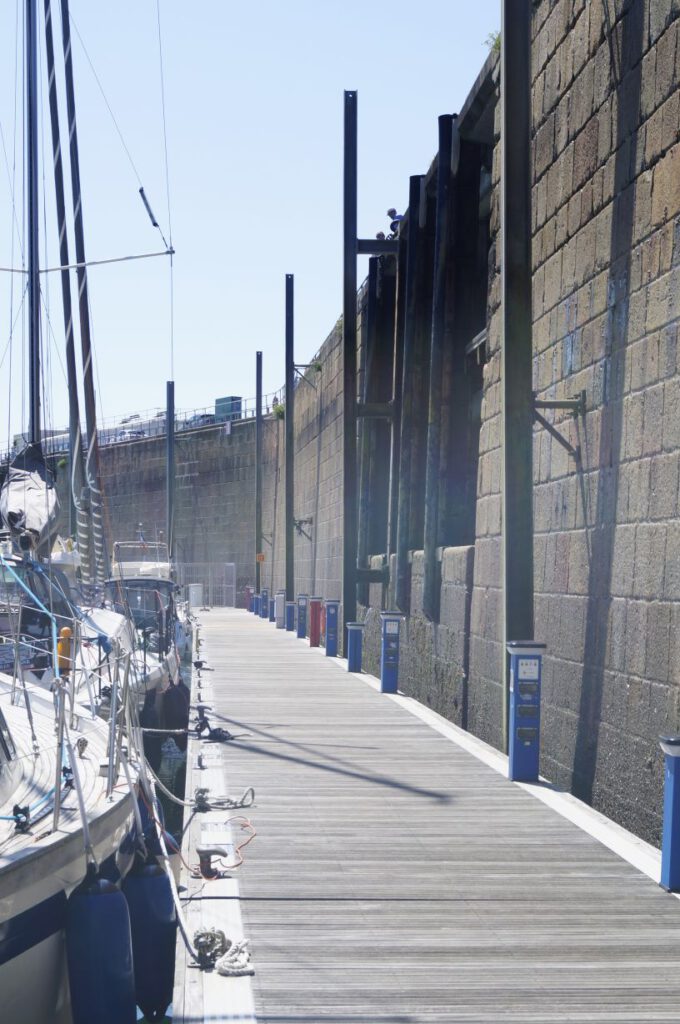
Jersey Albert Pier at low tide
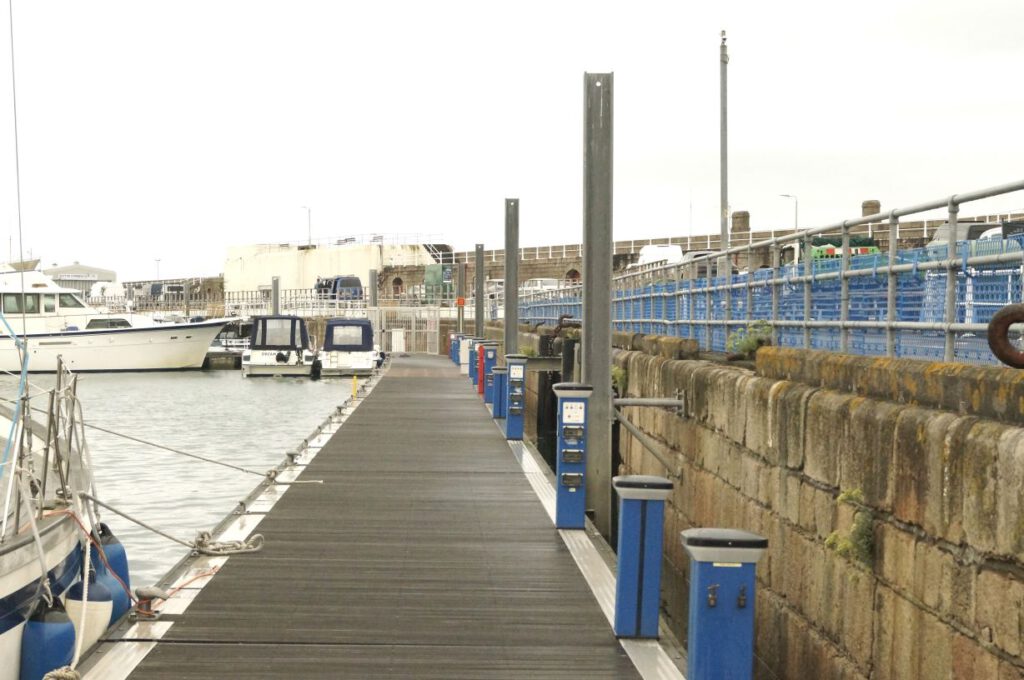
Jersey Albert Pier at high tide
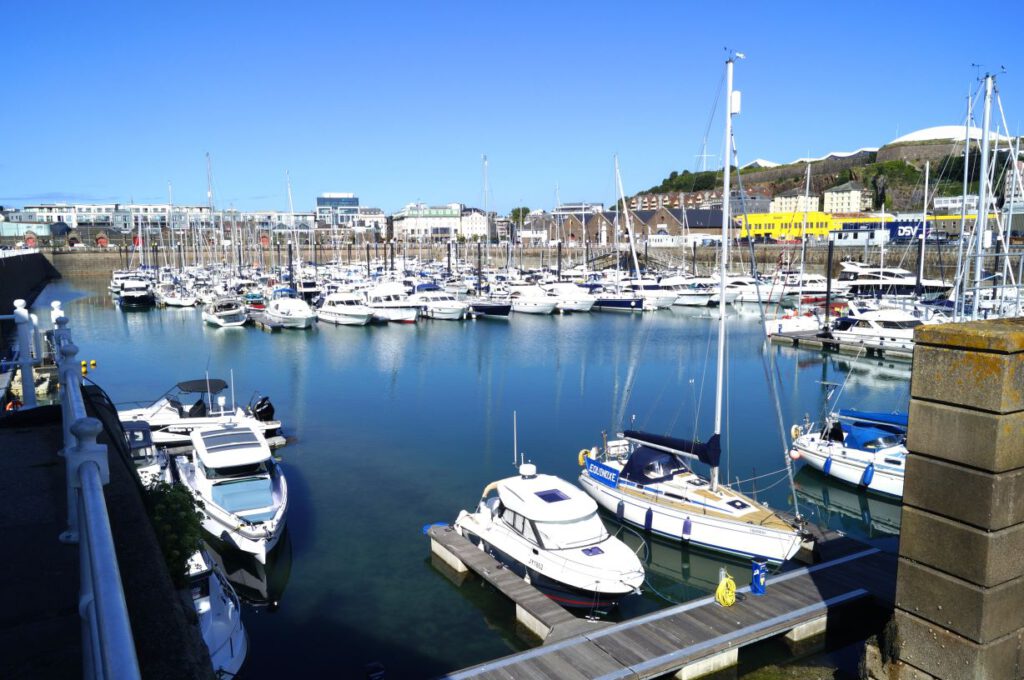
Jersey Marina
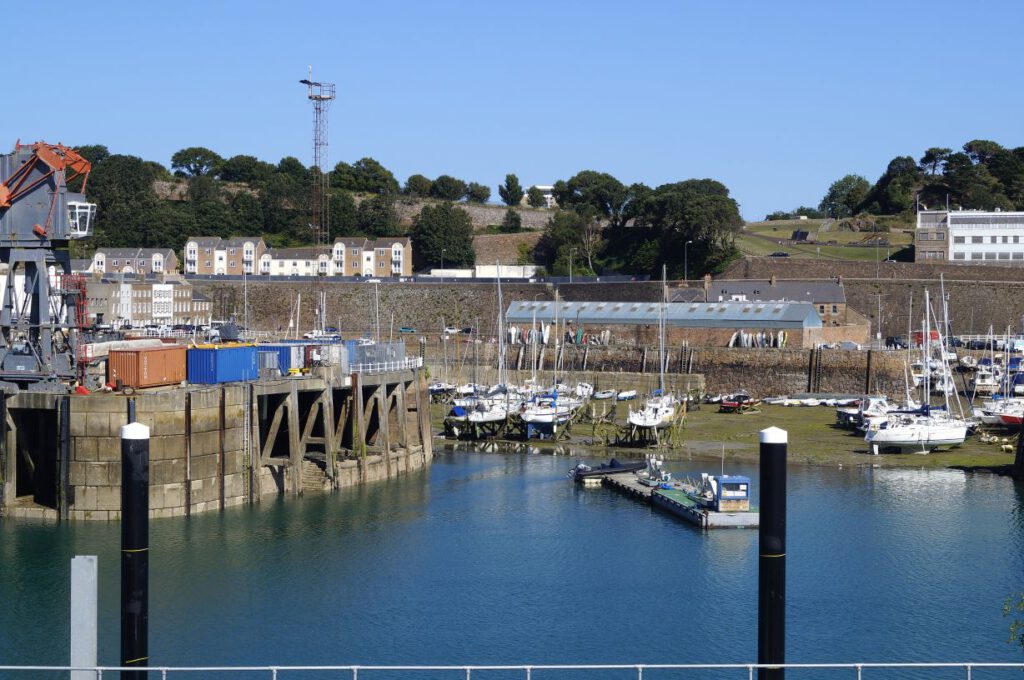
A harbour basin for boats that can be skilfully dropped dry, with supports or as a bilge keeler.
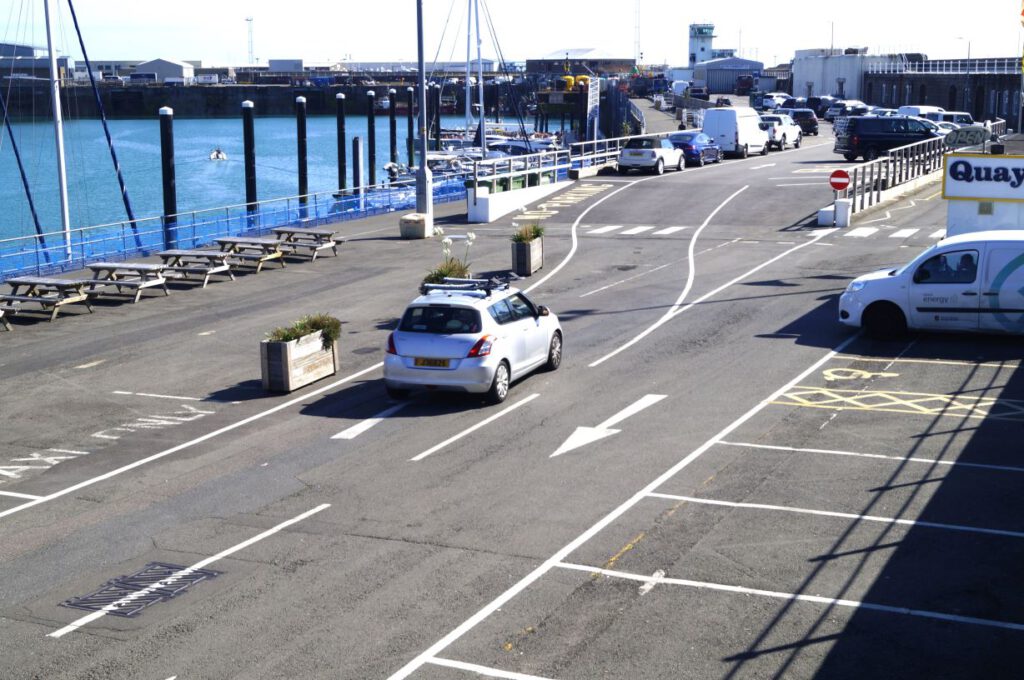
Well, once again you can see by the road, everything goes round to the left. And the time is different too.
16 August 2024
Le Havre
The engine is humming happily again, otherwise I wouldn’t have come to Le Havre. Unfortunately, the engine was used a lot again, so that was the ultimate test and it passed. I got it back on Tuesday 6th August, there was a weekend in between, so the time span was fine. I won’t say anything about prices, the Channel Islands are simply expensive.
On Wednesday we travelled on to Cataret. I hadn’t been there yet! I was able to sail the whole way with winds of around 3 to 4 Bft, and quite fast too. There was also a strong current, as we had a spring tide. And this current made me doubt for a moment before entering Cataret whether I should go in there. The current was running strongly across the entrance and the wind was also slightly against it, so rapids coupled with a windy sea. The sea in front of the harbour entrance was expected to be unpleasant. But the thought that we could only reach the next harbour, Dielette, at low tide made me head for this harbour after all. And the sea was quite unpleasant!
Cataret-Barnville, as it must be called in full, is a lovely little town. I stayed for 3 days, also to get back to the Neaptide for the rounding of Cape La Hague.
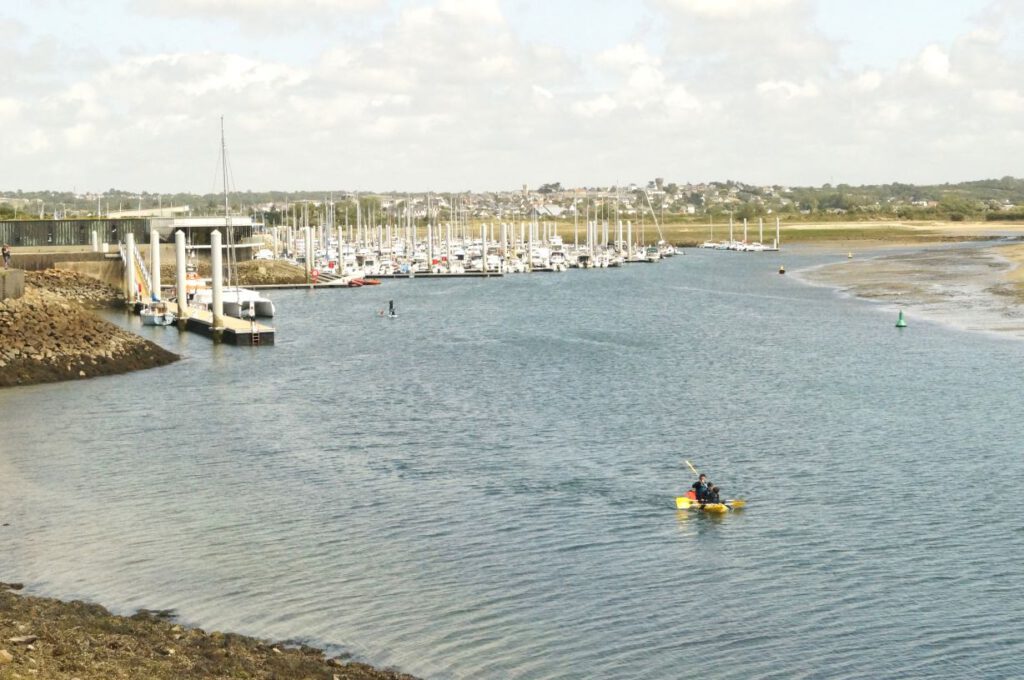
The harbour of Cataret-Barnville
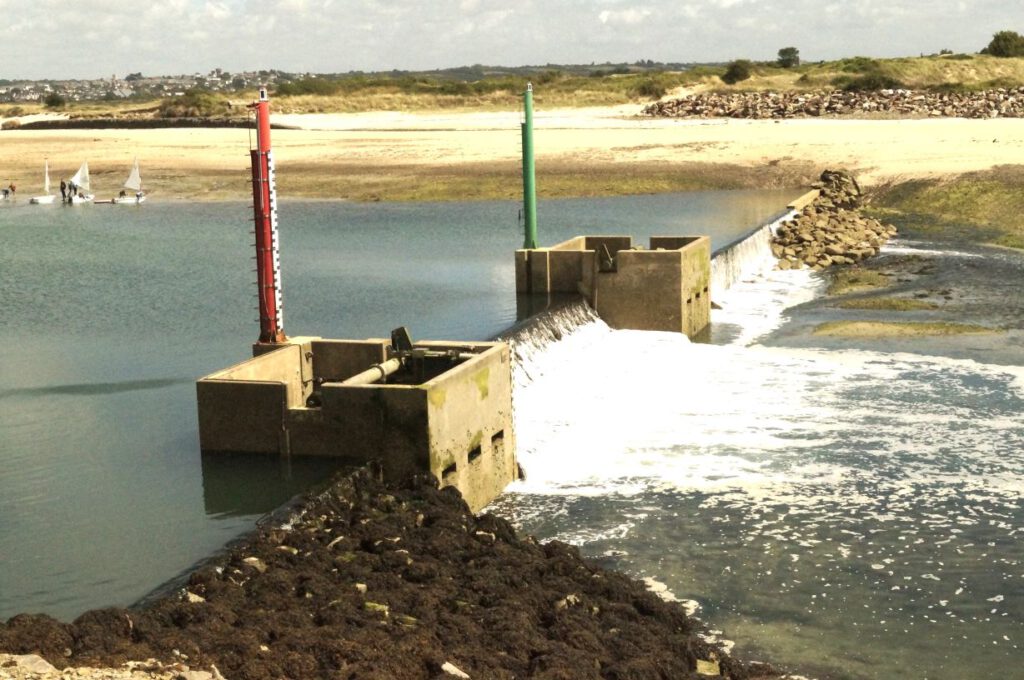
The Sill at low tide
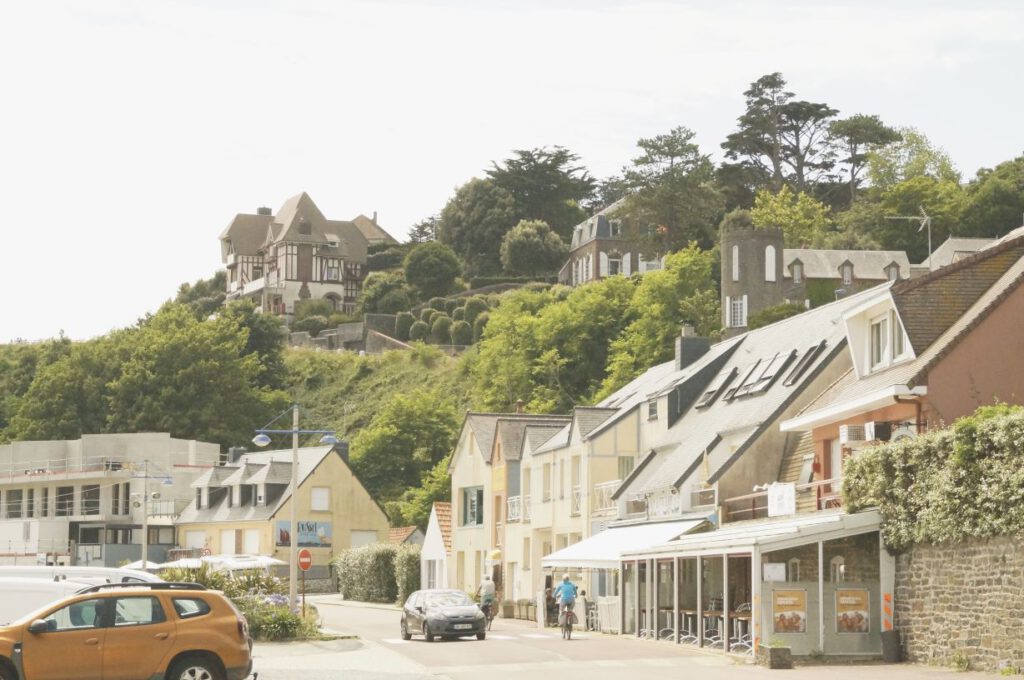
Small built-up hill directly at the entrance.
I still had a strong current for the trip around Cape La Hague. When I reached the top of Contentin, I was doing a good 12 knots over ground. I had my hands full steering and holding on myself. I was able to take two videos.
In front of the tip at about 8 to 9 knots over ground, with little wind. That’s why the engine was also running to maintain tiller pressure. Perhaps everyone has seen choppy water before, but probably not 1 to 1.5 metres high. There is no other way to describe it here, but fortunately only for about 30 minutes.
After the peak at 6 knots over ground and now with a strong breeze.
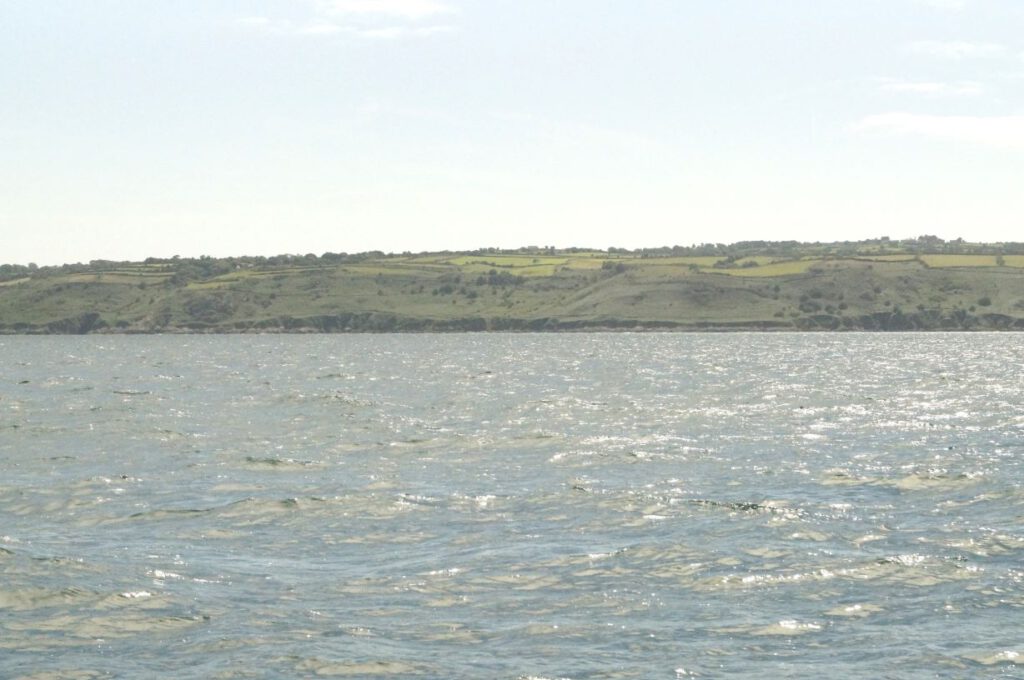
The north coast of the Cotentin peninsula really made a completely different impression on me than the coasts of Brittany and the south. Almost as ‘normal’ as the Baltic Sea.
In Cherbourg, I still found a few unknown corners, even though this is the fourth time I’ve been here.
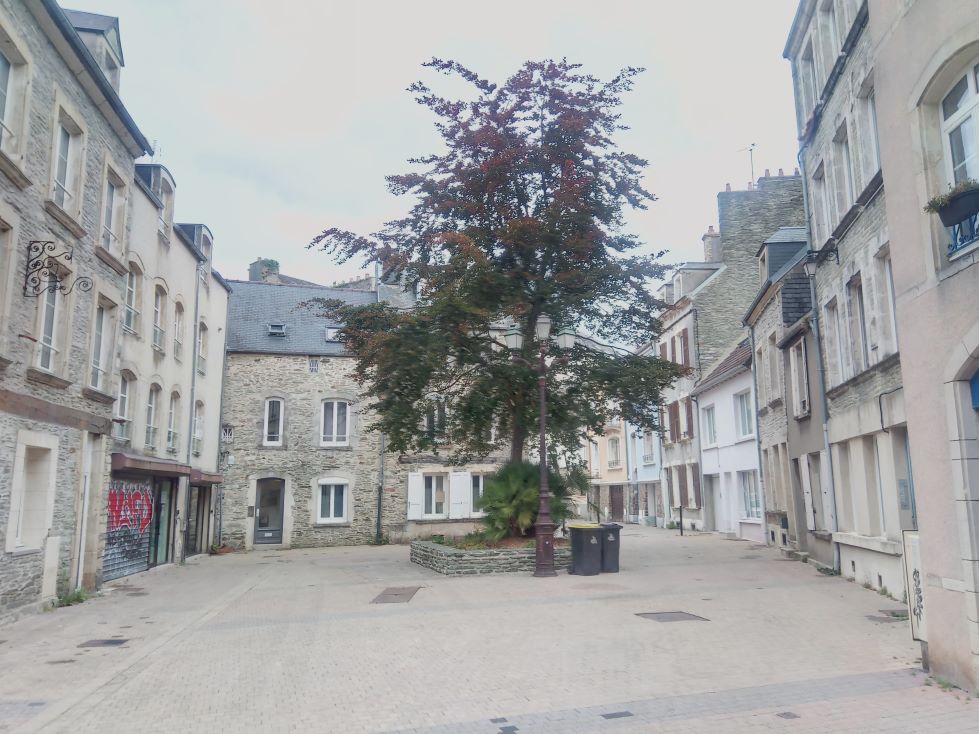
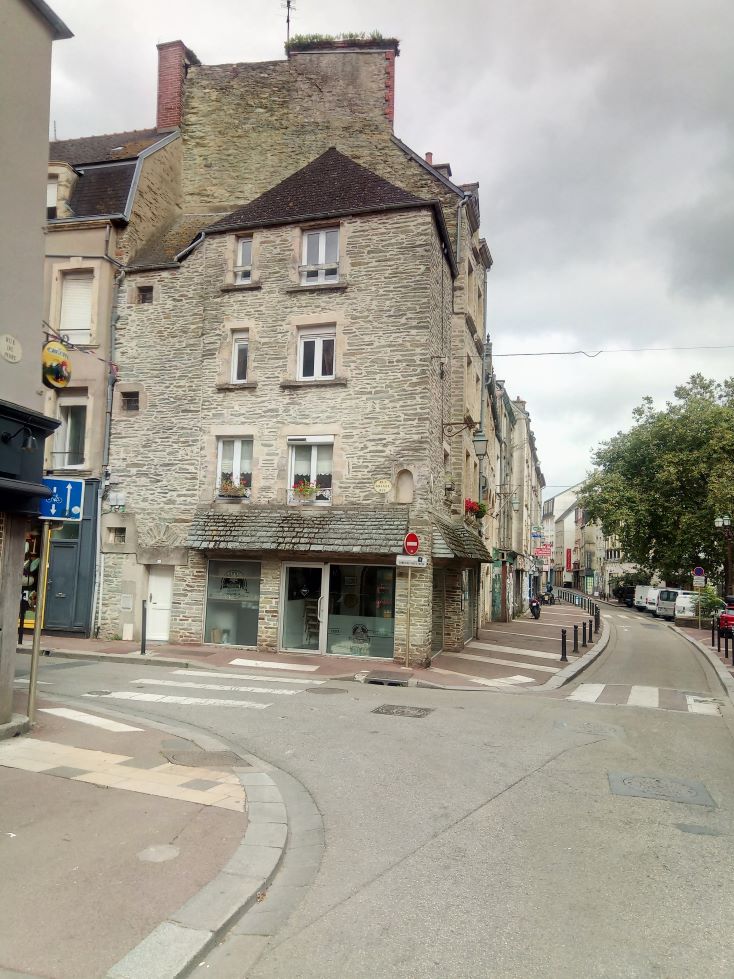
Old town
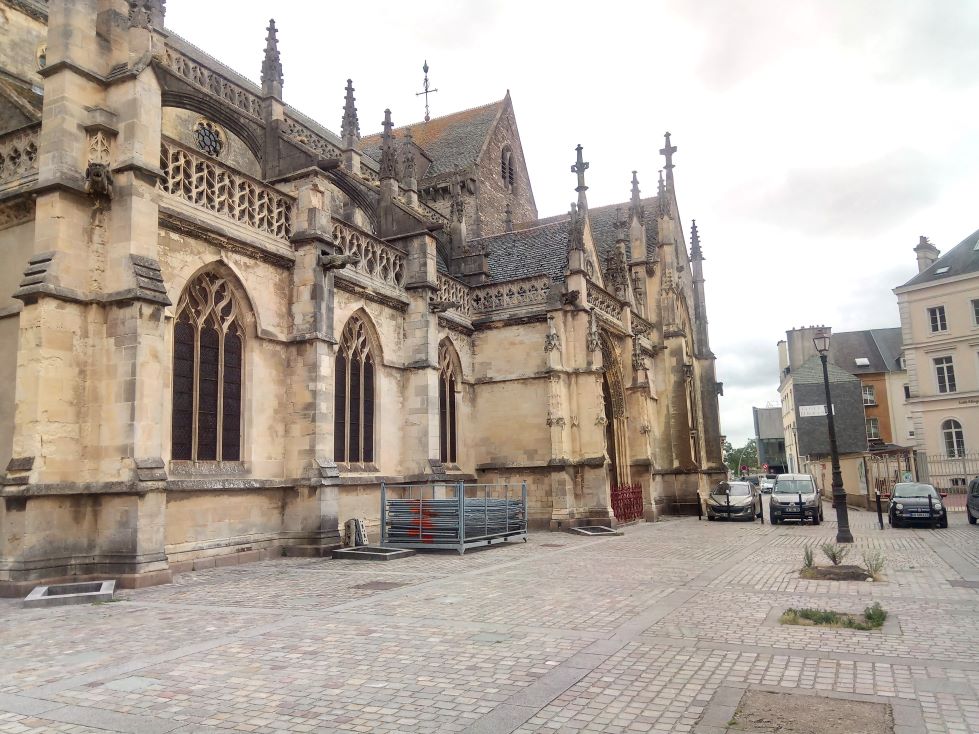
Church
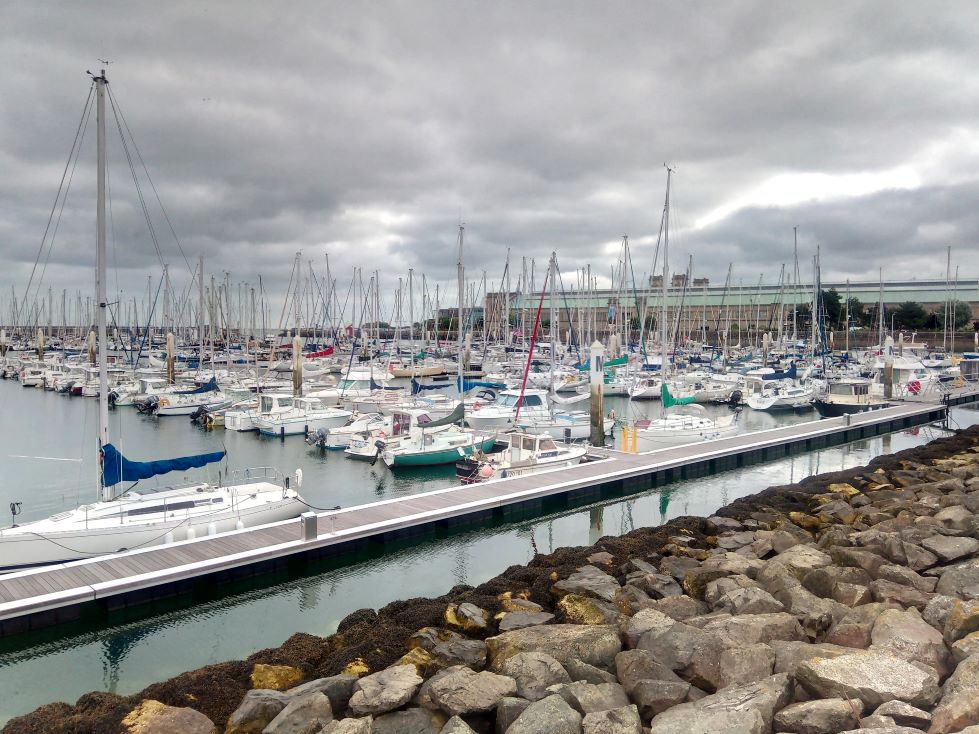
Well, the harbour is not unknown, but I’ve never captured it myself.
On the way to Saint-Vaast, the engine was once again running without a break, no wind, but there was still a good current.
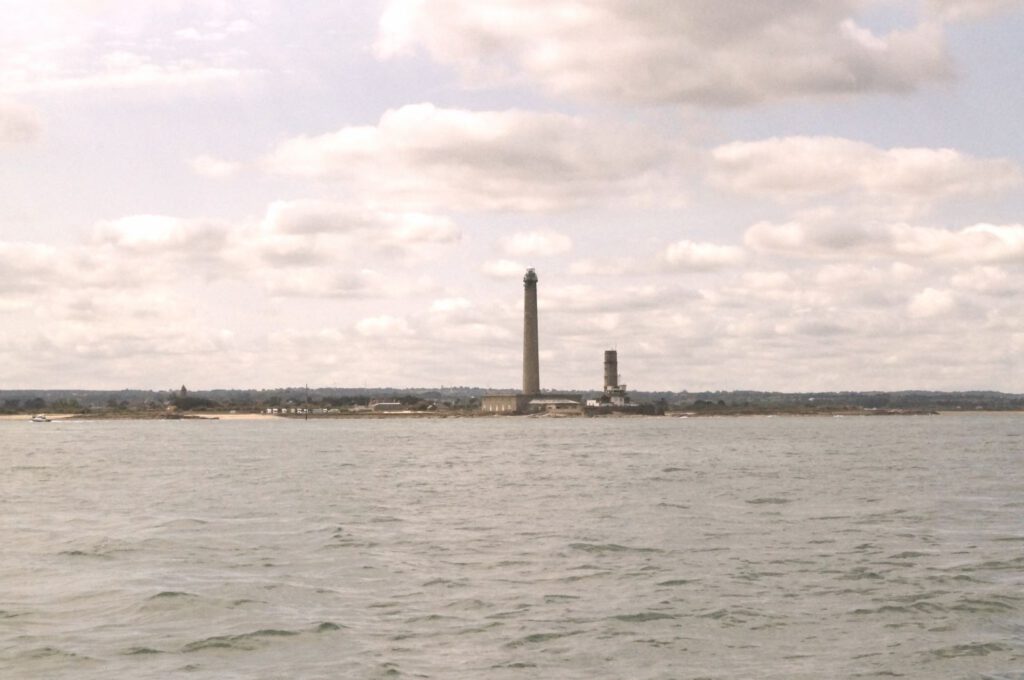
The Phare de Barfleur
Saint-Vaast is a high water harbour, everything falls dry in front of the harbour. A dock lock protects the harbour.
They are always in a hurry. As soon as the gate is only half-open, it goes through.
Docking of the ferry is very special here.
I had to stay one day, the tide was running too early and there was northern European drizzle for half the day.
A few impressions from Saint Vaast
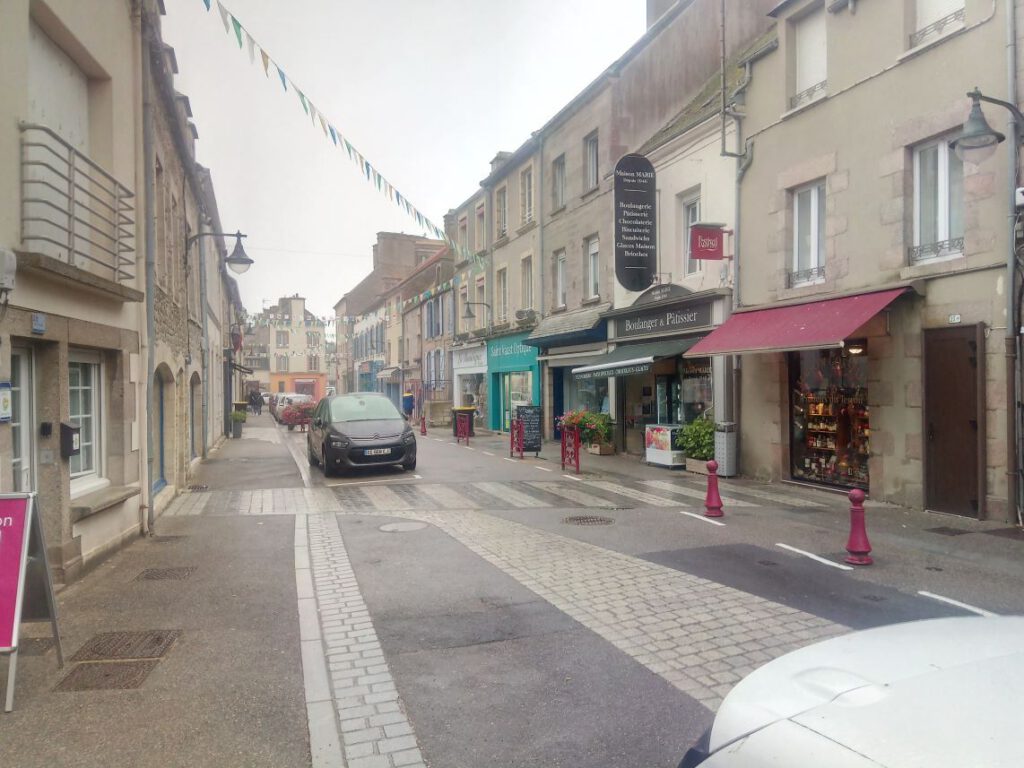
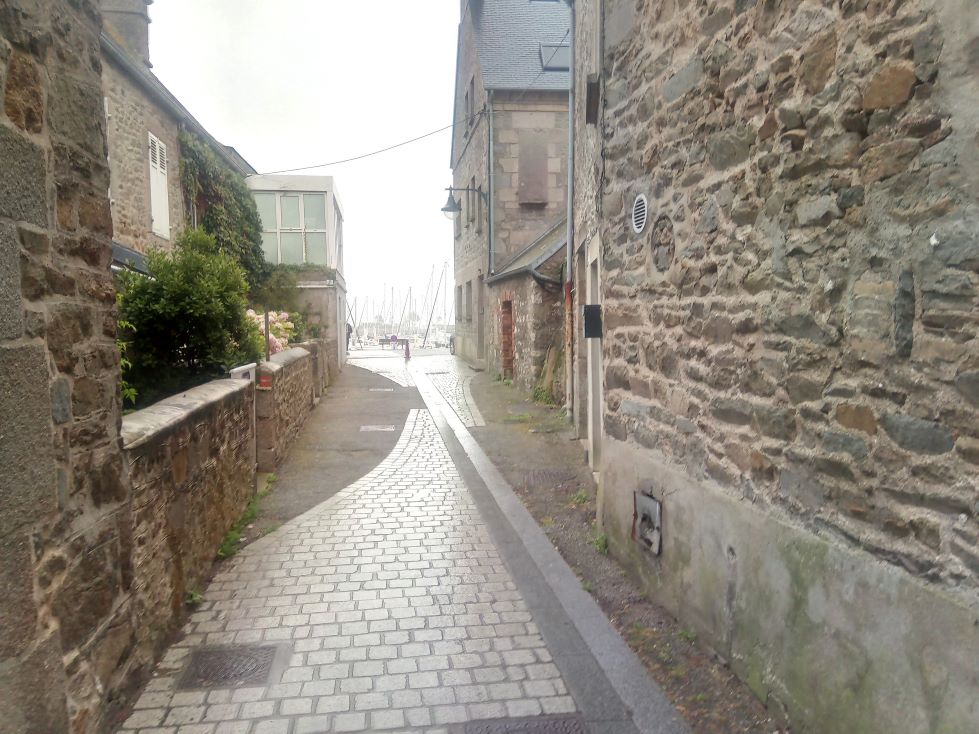
Rainy dreariness
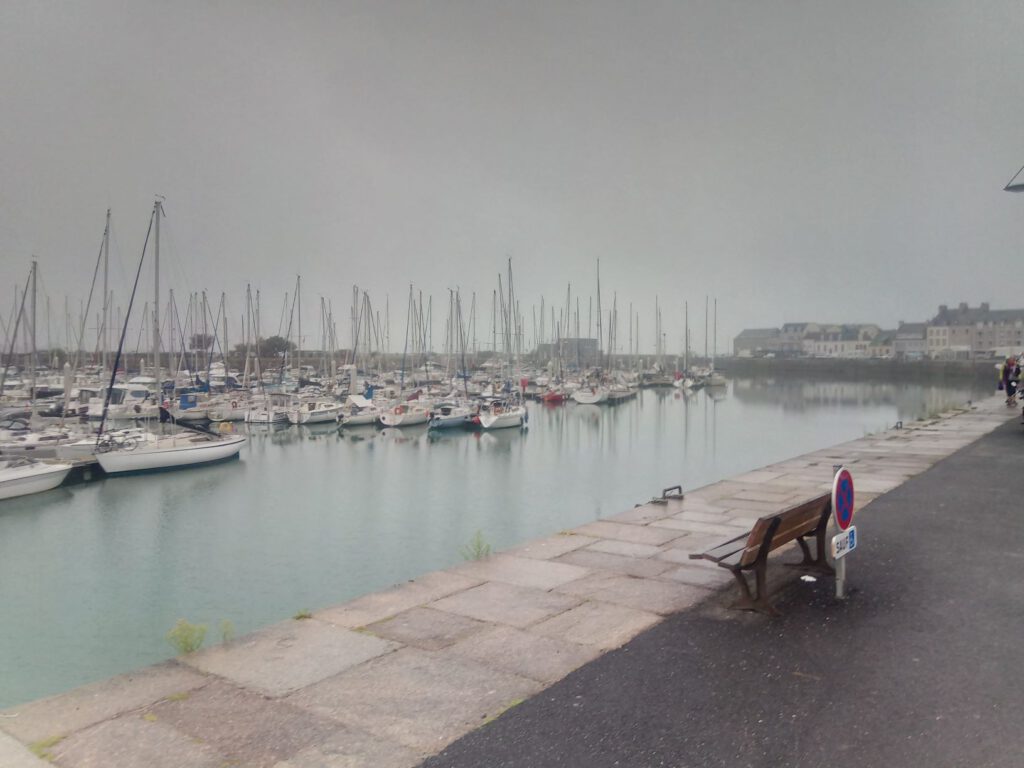
The harbour
From Saint-Vaast de la Hougue to Le Havre I made a long trip of a good 11 hours. I was only able to sail for about 4 hours, with winds from astern and an annoying rocking sea. Now there’s another day with rain, but it’s not bad for resting either. It looks like I’ll be making good progress from now on.
Thursday, 29 August 2024
Dunkirk
It wasn’t Calais, it was Dunkirk, because I skipped Calais. After an 8-day forced break in Dieppe, I was in a hurry. The weather forecasts change almost every day, so I can’t venture any more predictions. When it’s more or less right, I do long stretches.
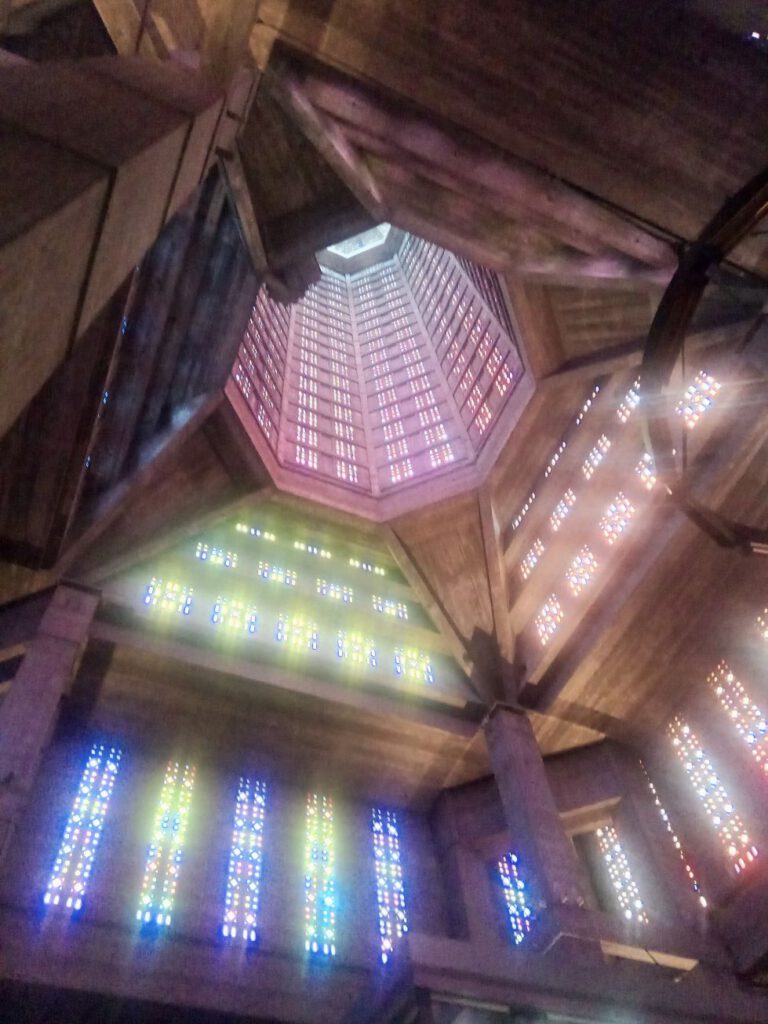
Le Havre St Joseph’s parish church
I would need a lot of time to take good photos of the inside of the church tower. The refraction of light and the play of colours are phenomenal. You probably have to experiment to take a perfect photo.
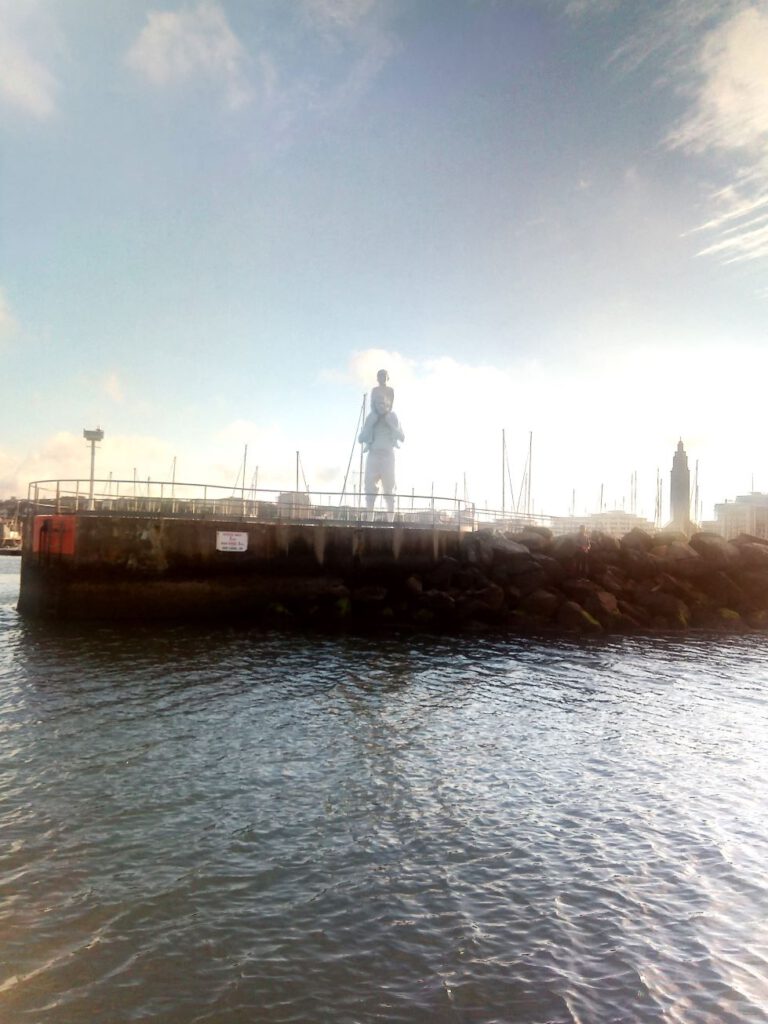
A giant with a child on his shoulders stands on the pier.
I got my first impression of the autumn weather in Fécamp. At least the clouds spoke for themselves, even if the sea and wind were still holding back. It was a different story in Dieppe. The wind blew from the west for days and a large swell built up.
As always, this can be seen impressively at the pier.
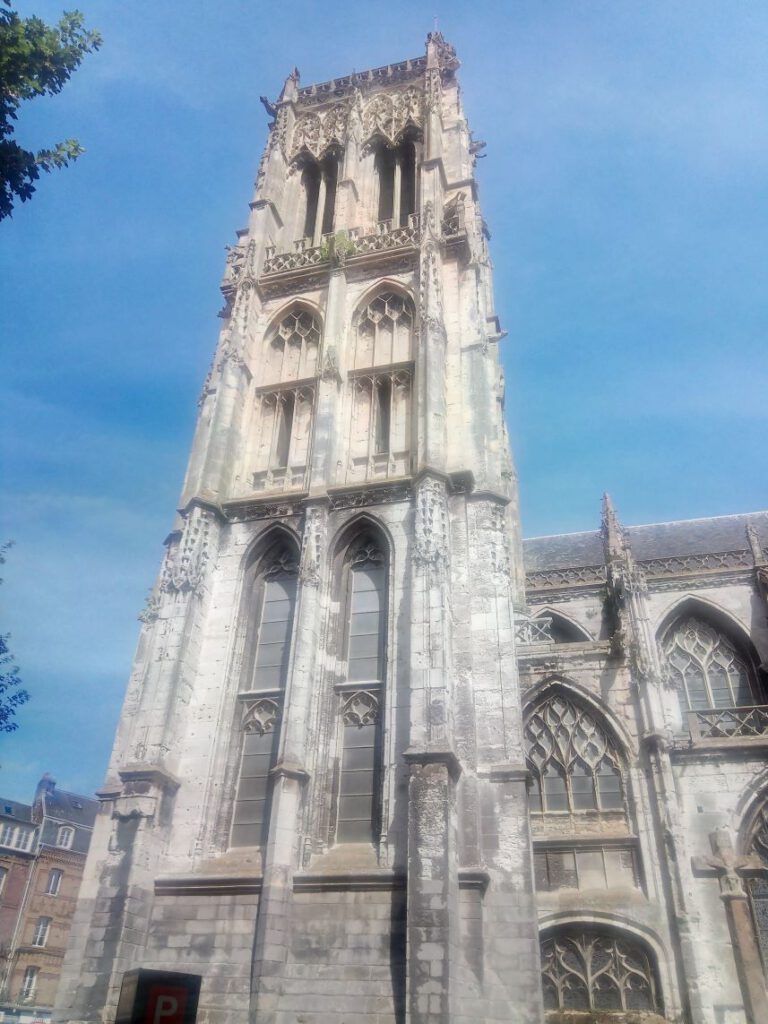
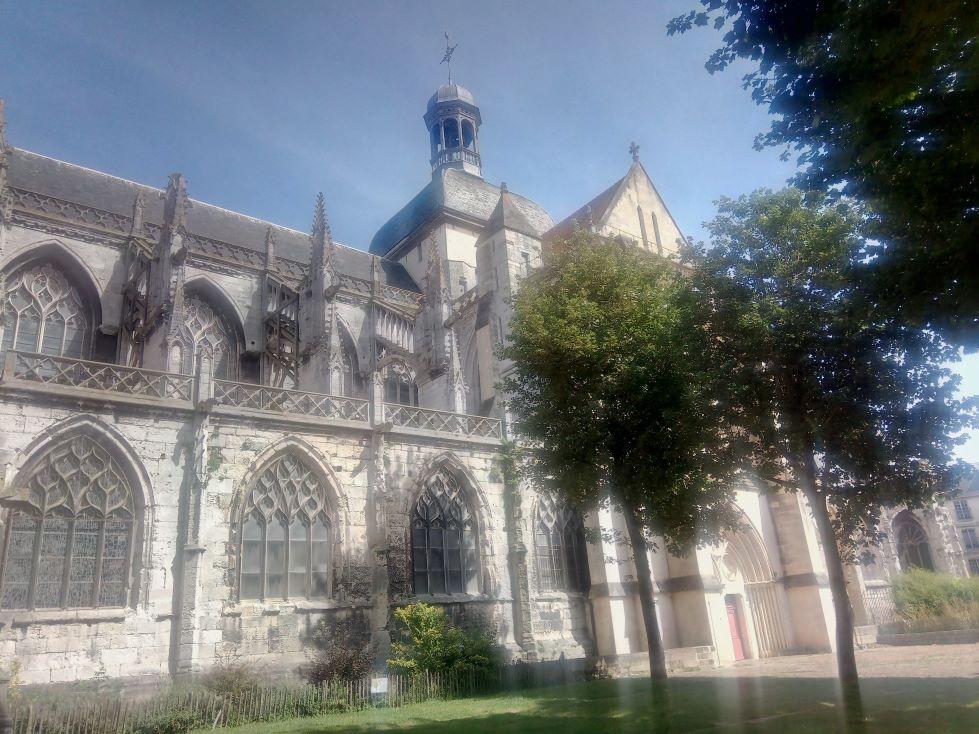
Yes, I took a picture from the church here too, they are simply imposing buildings.
The tidal range is of course particularly easy to observe here.
Full harbour
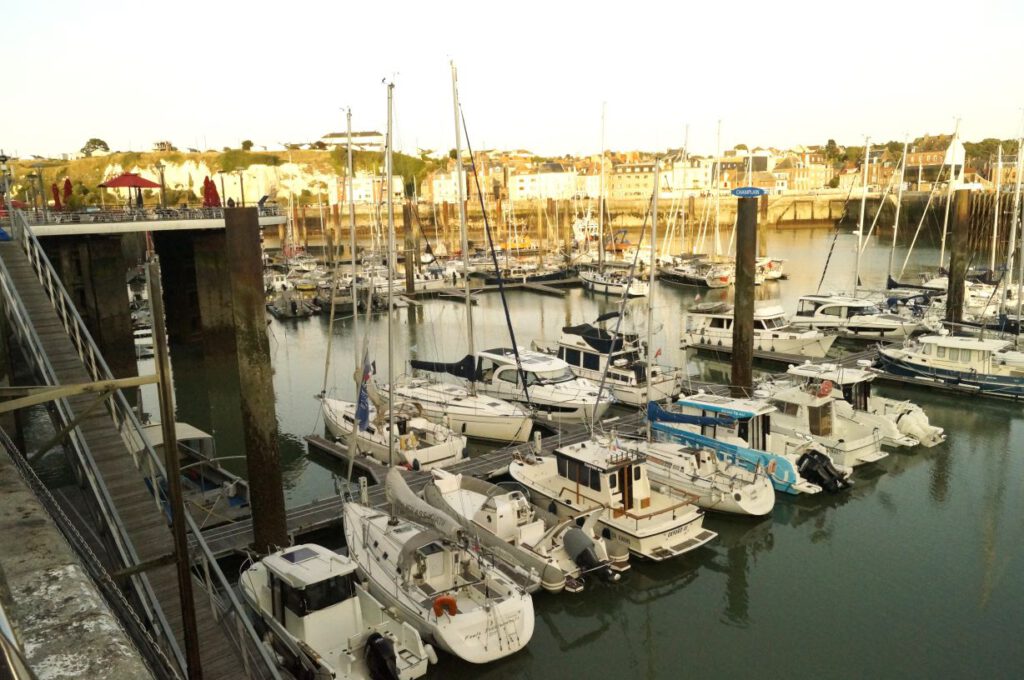
Empty harbour
After 8 days, the swell had calmed down a little. View of the entrance from above.
The long trip to Boulogne offered itself, first a little against the current and then only with the current. Unfortunately, I was only able to sail for 2 hours. It wasn’t very rocky, but it was enough to cause problems with the engine. In Fécamp it also stopped working for a short time. But after one night it ran smoothly again. What was going on? In any case, we cast off without any problems.
The journey around Cap Gris Nez was rough again and I needed engine assistance. There was too little wind for the swell from three directions. Well, the result: now the engine didn’t want to run at all in the lower speed range. In Dunkirk, getting underway was quite an art. But I still had to get to Belgium before unfavourable wind conditions returned. An engine stopping out is a challenge when mooring, as you have to judge the rest of the journey well in order to get into the pits without a scratch. I’ve got used to it by now.
Now the end: Back to home
